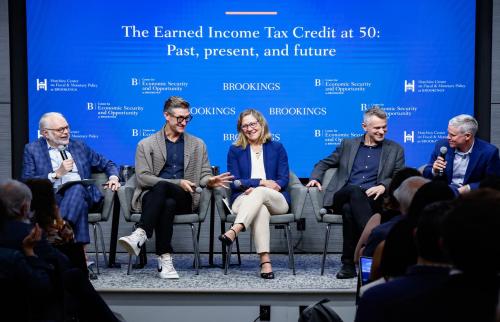Child poverty is center stage in current policy debates, at last. Far too many American children grow up poor. One in seven children live in poverty, according to the official poverty measure; one in eight by the supplemental poverty measure (which accounts for government transfers).
President Biden has just signed into law a bill that fundamentally restructures the child tax credit for one year as part of a larger relief package. The policy expands the child tax credit and delivers it periodically rather than as a lump sum at tax time—effectively instituting a child allowance administered through the tax code. Under the plan, low- and middle-income families with children will receive a yearly total of $3,000 per child aged 6 to 17 and $3,600 per child under 6.
Looking at the supplemental poverty measure (SPM), this single provision is projected to reduce child poverty from nearly 14 percent to 7 and a half percent—a 45 percent reduction—according to researchers at Columbia University’s Center on Poverty and Social Policy. The payments are projected to drastically cut child poverty across racial groups, but with particularly large reductions for Black, Hispanic, and Native American children. Similar reductions are expected for the number of children living in deep poverty.
The significance of this moment in U.S. social policy is hard to overstate. In one year, the relief package as a whole is projected to cut the child poverty rate in the United States by more than half. For context, the child poverty rate declined from 17 percent in 2009 to 12 and a half percent in 2019—a 26 percent decline over ten years.
The real question now is whether the restructured child tax credit will be maintained for more than a single year. Clearly that is the hope and plan of the White House and Congressional Democrats. And there is at least some bipartisan support for an aggressive move against child poverty. Senator Mitt Romney released a similar proposal that, among other things, would have introduced an even more generous child allowance, but delivered through the social security system—a similar approach to Melissa Kearney’s call for “social security for kids.”
One of the most important criticisms of the more generous child allowances is that, even if they cut poverty in the short-term, they will undermine social mobility over the longer term, not least by disincentivizing paid employment among parents. We show here that this is a false choice. Child allowances are a powerful anti-poverty policy; but they are pro-mobility policy, too.
What is the most important goal: cutting poverty or improving mobility?
It is important to state here that reducing child poverty is not the only goal for social policy. It is just as important—arguably more important—to pursue policies that will improve longer-term outcomes. Giving a family enough extra money to put them a few dollars above the poverty line is good in itself, but an important question is how much it improves the future prospects of the children in the household, not just their current conditions. Policy should aim to lift children out of poverty both in the short-run and the long-run. We should be aiming to improve the “moving picture” of inequality—mobility from poverty.
Policymakers will likely pursue both goals. But a criticism of child allowances, made by the American Enterprise Institute’s Scott Winship and others, is that they will do little to advance, and may even inhibit, intergenerational upwards mobility. As Winship (a friend and frequent co-author) wrote of the Romney plan: “Child allowance advocates assume that point-in-time poverty is all that matters, but if their preferred policy incentivizes more behavior that impedes intergenerational mobility, they will have won a battle while losing the long-term war on poverty.”
It is important to distinguish this form of argument from the rhetoric of some conservative commentators who are resorting to slippery-slope arguments about universal basic income. Winship is making a good-faith empirical argument: just one that we disagree with.
Winship’s argument largely rests on the estimated impact of child allowances on rates of marriage and employment. Differing views on these questions have been on display in a lively argument among commentators and scholars on both the political left and right in recent weeks. Indeed, there are very different opinions among scholars even within the American Enterprise Institute, proof of its commitment to a “competition of ideas.”
The broad consensus as we interpret it is that child allowances will have uncertain, modest effects on employment and family formation, but clear and large effects on current poverty levels.
For some observers and analysts, especially pro-market conservatives, any negative impact on employment, however small, would be a deal-breaker. For others, including pro-family conservatives, it is less obvious that such employment effects should be automatically seen as undesirable. Making it possible for some parents to spend more time with their children instead of in paid work might be considered a positive outcome of child allowances. In any case, employment responses to child allowances are likely to be small because a universal child allowance would not change the returns to work. This is in contrast to older safety net programs, such as Aid to Families with Dependent Children (AFDC), which had strong work disincentives since participants lost benefits—sometimes dollar-for-dollar—if they worked for pay.
But what is missing from these debates is the evidence that cash transfers can be pro-mobility policies in themselves. In which case, giving cash to families with children will both reduce child poverty today and increase mobility out of poverty tomorrow.
Cash today, better outcomes tomorrow
Can cash today mean mobility tomorrow? A child allowance would be a new component of U.S. social policy. Such a policy, by definition, cannot have been evaluated in terms of long-run outcomes. However, many studies examine policies similar to giving cash to families with children—and most point in the same direction.
- First, our colleague Randy Akee and coauthors have conducted a series of studies on the distribution of Casino profits to adult members of the Eastern Cherokee reservation in western North Carolina. They find that unconditional, per-capita payments increase children’s educational attainment in young adulthood. Another study finds that the payments improve children’s emotional and behavioral health and parent-child relationships. However, a third study finds the unconditional cash payments increase children’s body-mass index in young adulthood. Of course, these papers look at a specific context and subpopulation, but the core story is there: cash can help kids in the long run.
- Second, a recent paper uses linked administrative records to examine the Mothers’ Pension program in the early 20th-century, the original precursor to Temporary Assistance for Needy Families (TANF). They find that sons of mothers who received benefits had better health outcomes: they lived longer and were less likely to be underweight. Sons also had more years of education and earned higher incomes in young adulthood. Of course, the historical context warrants caution when applying these findings to current policy proposals. However, the paper clearly shows that giving cash to low-income kids can improve their long-run health and human capital.
- Third, several studies have examined the long-term effects of the earned income tax credit (EITC) on children’s adult outcomes. Teenagers with higher EITC exposure are more likely to graduate high school and college, be employed as young adults, and have higher earnings. Looking at both the EITC and child tax credit, another study finds that tax credits increase test scores, especially for children in middle school. By making some assumptions about the relationship between test scores and adult earnings, the authors calculate that each dollar in tax credits yields more than a dollar in adult earnings. Several other studies find similar impacts of the EITC on children’s test scores and educational attainment. Further, a recent study found that the EITC increases intergenerational mobility, especially for kids with married parents. To be clear, these studies are really evaluating two policy levers: cash and work incentives. It is unclear how much of these effects can be attributed to the cash part of the EITC and how much to increased employment. But, these studies clearly show that conditional cash (rather than in-kind benefits) can be an investment in the long-run success of children.
- Fourth, evidence also shows that the Supplement Nutrition Assistance Program (SNAP) helps children in the long run. A recent study combines Census and Social Security data to study the introduction of SNAP (then Food Stamps) in the 1960s and 1970s. They find exposure to SNAP before age 5 leads to better outcomes in adulthood, including higher human capital, higher economic self-sufficiency, and increased life expectancy. The authors calculate that SNAP has an extremely high return on investment: per dollar of net cost to the government, SNAP generates $56 in benefits. SNAP, of course, is not cash, but it is “near cash”—as long as a household’s food budget does not exceed the value of SNAP benefits, SNAP effectively frees up cash for other purchases. Therefore, the effects of SNAP can be instructive when thinking about long-run benefits of a child allowance.
None of these studies are perfect comparisons for a variety of reasons—and each group of papers has a different set of shortcomings. Yet, they all suggest that cash for kids can improve their adult outcomes. Each individual study should be taken with a grain of salt, but taken together, they comprise a decent body of evidence pointing to the potential pro-mobility effects of a child allowance.
Child allowances: Great for reducing poverty, good for increasing mobility
It is useful, as Winship does, to distinguish between the two goals of alleviating material deprivation today, and promoting better material outcomes in the long run. It can be useful to think of these goals in terms of consumption and investment. They are unlikely to directly conflict, but there will be many policies that serve one goal much better than the other.
Policymakers will typically seek to blend and balance programs to achieve the twin goals of reducing poverty today (consumption), and improving mobility in the future (investment). An additional year of quality pre-school for low-income children is likely a more powerful pro-mobility policy (especially dollar for dollar) than a child allowance—but of course does nothing for immediate poverty reduction.
A direct cash transfer, then, can be both a powerful anti-poverty policy, and likely to be a pro-mobility policy, too: the policy equivalent of a two-fer. These may be important considerations in the coming arguments over whether to make the new child tax credit permanent.
The Brookings Institution is committed to quality, independence, and impact.
We are supported by a diverse array of funders. In line with our values and policies, each Brookings publication represents the sole views of its author(s).








Commentary
New child tax credit could slash poverty now and boost social mobility later
March 11, 2021